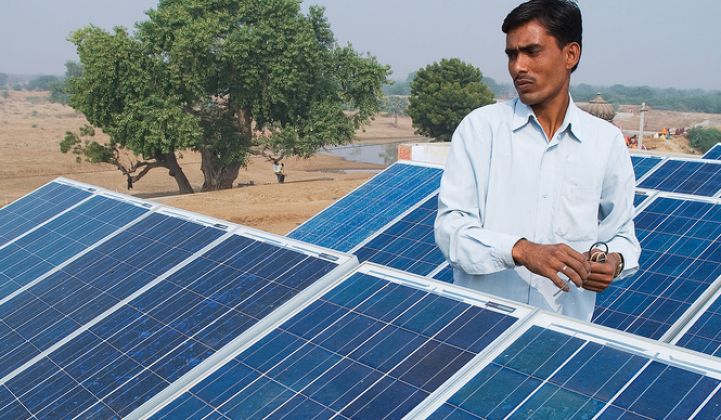The spotlight will turn to India next Monday when President Obama joins Prime Minister Narendra Modi at India’s Republic Day celebrations -- a first for a U.S. president.
The two leaders have a packed agenda for the president's three-day visit, which will include discussions about energy. But don't expect a climate deal similar to one crafted by China and U.S.
Last year, India’s new environment minister categorically stated that India, whose per capita emissions are lower than those of U.S. and China (1.7 tons CO2 per capita), has no intentions of reducing greenhouse gas emissions in the near future. Instead, the new government’s priority is to meet its energy deficit by significantly increasing coal production, which already accounts for more than 60 percent of India’s electricity generation.
Further, the minister in charge of power and coal (who interestingly also heads the Ministry of New and Renewable Energy) plans to double India’s coal output by 2019, to 1 billion metric tons, by approving several old and new coal projects.
Meanwhile, the clean energy industry has been celebrating India’s recent policies promoting solar development. The new government has set an ambitious target to procure 100 gigawatts of solar capacity by 2022. And just last week, SunEdison announced a $4 billion investment to build a factory for manufacturing lower-cost solar panels in India.
These developments will boost India’s nascent solar industry, which currently accounts for less than 1 percent of power generation in India. They may allow solar to meet as much as 10 percent of India’s electricity demand by 2022.
Solar could significantly change India’s electricity mix. But a pro-solar policy in isolation will not translate to a drop in emissions -- not when India still has no cohesive plan to phase out fossil-fuel electricity generation and transition to a low-carbon economy.
Realizing the goal of 100 gigawatts of solar will also bring many challenges of its own. Power distribution companies in India, which are entirely state run, have set dismally low renewable purchase obligation targets of 3 percent by 2022, and most states have been failing to meet current targets year after year. These obligations are not enforced or regulated, increasing uncertainty around new large solar projects.
Moreover, Indian utilities rely on large industrial and commercial consumers to subsidize electricity for all other customers, and are wary of independent renewable power producers taking away large consumers and depriving them of their main source of profit.
As a result, independent solar (and wind) projects are subject to restrictive open-access policies, as well as high wheeling and cross-subsidy charges that prevent renewable energy from being cost-competitive. Such prohibitive policies need to be eliminated and the electricity sector must be deregulated if India hopes to achieve its solar targets. There is hope for this given that the parliament is debating changes to the Electricity Act of 2003 and the Ministry of New and Renewable Energy has proposed eliminating wheeling charges for upcoming solar parks.
However, the electricity sector is not the only problem. Manufacturing and transportation account for a major share of emissions and harmful air pollutants as well. The 2014 Environmental Performance Index ranked India 174th out of 178 countries for air quality, barely ahead of Pakistan, Nepal, China and Bangladesh. Meanwhile the government is reluctant to improve air quality and has even denied that vehicles are responsible for hazardous air quality in cities. As India’s traffic problems worsen and fuel consumption increases, stricter measures will be needed in order to curb the respiratory illnesses that are growing at an alarming rate.
It is clear that India’s approach to development thus far has not been successful in achieving desirable health outcomes. If the country's preferred strategies include doubling down on coal production and increasing oil consumption, the future looks rather bleak.
Simply increasing the amount of solar power without drawing up specific timelines and targets for emission reductions will not help India deal with climate change and lower the health impact of pollution.
It’s time for India’s new government that came to power with the promise of “achhe din aayenge” -- meaning “better days are ahead” -- to lead the way to a cleaner, secure future without repeating mistakes that we now know can be avoided.
In order to have a meaningful impact, India's 100-gigawatt solar target needs to be part of a larger suite of policies designed to reform the country's energy market and promote a low-carbon economy.
***
Chandrika Srivastava is a graduate student at Stanford University. Follow her on twitter at @chandrikasriv.



